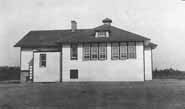In 1913, a three-room public school was built on the corner of Balsam Avenue and Second Avenue by the Mond Nickel Company. At the time of its opening, there was only enough students to fill two of the three classrooms and so the third classroom was rented out to the Separate School to accommodate its overflow of students.
 On February 26, 1918, a fire broke out at the public school while classes were in session. All of the students and teachers escaped without injury however, the school was completely destroyed. While the Mond Nickel Company rebuilt the school, classes were held in the Anglican and Presbyterian churches. Once the new three-room building was complete, the Separate School once again took over the use of the third classroom. This arrangement lasted until 1921 when the public school system received an influx of students. To accommodate its own student population growth, the public school evicted the Separate School class in favour of utilizing the spare room for its own pupils.
On February 26, 1918, a fire broke out at the public school while classes were in session. All of the students and teachers escaped without injury however, the school was completely destroyed. While the Mond Nickel Company rebuilt the school, classes were held in the Anglican and Presbyterian churches. Once the new three-room building was complete, the Separate School once again took over the use of the third classroom. This arrangement lasted until 1921 when the public school system received an influx of students. To accommodate its own student population growth, the public school evicted the Separate School class in favour of utilizing the spare room for its own pupils.
Coniston Public School boasted a baseball team put together by J.T. Kidd, the school principal. The team would compete against other public schools in the district and among its favoured competitors were the team from Creighton Mine (coached by their principal, Miss Ursula Black), and the team from Burwash (because the students got to travel by train for the game since there were no roads to Burwash at this time). The school also hosted an annual fall fair and a Christmas concert where Santa Claus would come to give gifts to all of the students, courtesy of the school board trustees.
In 1928, an annex was built adjacent to the school by the Mond Nickel Company to accommodate the growing number of students. This annex was used for five years before being closed and then subsequently reopened in 1938. By 1939, the public school introduced home economics and wood working classes to its students.
Throughout World War II, the public school experienced a period of slow growth, a condition which was soon remedied in the post-war years when student populations were once again on the rise. With the increase in students, the school required another addition in the form of a fourth classroom, a larger home economics room, a principal's office, an assembly hall, and a nurse's room. Also around this time, the sports program at the public school was reintroduced and boys and girls baseball teams would compete with other public schools in the area, most notably Wahnapitae.
Sometime in the late 1960's or early 1970's, the public school board received word from the Department of Education that it would have to maintain an enrollment of at least 100 students in the current school term in order to keep from becoming part of the Neelon-Garson School Board. The Coniston Public School had an enrollment of 96 students at that time and were certain to obtain the required 100 students by the next school term, but it was too late. Despite appeals to the Minister of Education by the Town Council, the school became part of the larger School Board the following September. The administration of the Coniston public school was moved to Garson and the amount of influence the Coniston board members had was negligible. Eventually, some of the students were transferred to the schools in Garson to take advantage of certain educational opportunities.
When the Regional Government was formed in 1973, the Neelon-Garson School Board was taken over by the Sudbury Board of Education. With this amalgamation, the Sudbury Board of Education became responsible for the entire area from Skead to the French River. Five years later, in the fall of 1978, the school board decided to close Coniston Public School. The students were subsequently bused to Wahnapitae or Garson to receive their education.
Today, children of Coniston in the public school system continue to attend schools in other communities throughout the City of Greater Sudbury.
Material compiled from The Coniston Story.

 Greater Sudbury Guestbook
Greater Sudbury Guestbook
 Home Page
Home Page
 Greater Sudbury Histories
Greater Sudbury Histories
 Public School
Public School



